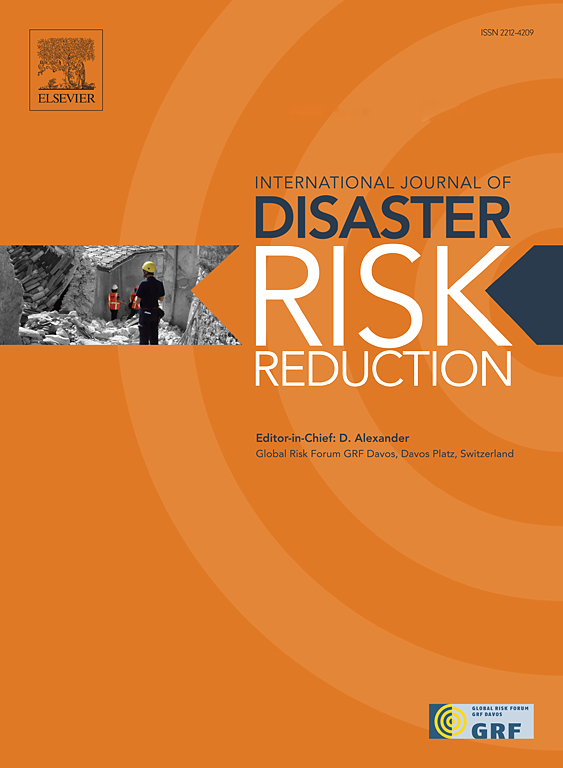Flood vulnerability of rural women – An indicator-based approach
IF 4.2
1区 地球科学
Q1 GEOSCIENCES, MULTIDISCIPLINARY
International journal of disaster risk reduction
Pub Date : 2025-03-17
DOI:10.1016/j.ijdrr.2025.105404
引用次数: 0
Abstract
In Kerala, floods are considered as a major and most frequent hazard affecting about 14.8 % of the area and 52 % of the population being vulnerable to flood impacts. There are large differences between men and women in terms of impacts, vulnerabilities, and capacity to adapt to these challenges. Rural women are hard hit by the flood impacts especially due to constraining gender norms and high dependence on agriculture. Hence, the study aims to assess the Flood Vulnerability Index of Rural Women (FVIRW) for the selected Agro-ecological Units (AEUs) of Kerala, using the three dimensions of vulnerability viz, Adaptive capacity, Sensitivity and Exposure, under which 9 major components and 69 indicators were selected. The study was conducted in Pokkali Land and Kuttanadu AEU and was based on the primary data collected from 200 rural women through personal interviews. The developed FVIRW value indicated that rural women in both Pokkali Land (0.562) and Kuttanadu (0.551) are highly vulnerable. Probing into the dimensional values showed that Pokkali Land, had higher index value (0.679) for exposure followed by sensitivity dimension (0.671) and adaptive capacity (0.471). In case of Kuttanadu, the exposure dimension had higher value (0.687) followed by sensitivity (0.640) and adaptive capacity (0.464) dimension. In depth analysis in to the components like socio-demographic profile, livelihood strategies, socio-economic assets, water, health, and food indicated the need of urgent interventions at policy level. Hence to improve the current situation, adaptive interventions like schemes to improve the credit borrowing capacity of the women, linking women organizations to credit cooperative institutions, and mitigation interventions like conducting trainings on flood risk management and technology adoption, and insurance on assets loss can be implemented. The FVIRW developed can also be extended to other prominent flood vulnerable tracts of Kerala and other places with necessary modification.
求助全文
约1分钟内获得全文
求助全文
来源期刊

International journal of disaster risk reduction
GEOSCIENCES, MULTIDISCIPLINARYMETEOROLOGY-METEOROLOGY & ATMOSPHERIC SCIENCES
CiteScore
8.70
自引率
18.00%
发文量
688
审稿时长
79 days
期刊介绍:
The International Journal of Disaster Risk Reduction (IJDRR) is the journal for researchers, policymakers and practitioners across diverse disciplines: earth sciences and their implications; environmental sciences; engineering; urban studies; geography; and the social sciences. IJDRR publishes fundamental and applied research, critical reviews, policy papers and case studies with a particular focus on multi-disciplinary research that aims to reduce the impact of natural, technological, social and intentional disasters. IJDRR stimulates exchange of ideas and knowledge transfer on disaster research, mitigation, adaptation, prevention and risk reduction at all geographical scales: local, national and international.
Key topics:-
-multifaceted disaster and cascading disasters
-the development of disaster risk reduction strategies and techniques
-discussion and development of effective warning and educational systems for risk management at all levels
-disasters associated with climate change
-vulnerability analysis and vulnerability trends
-emerging risks
-resilience against disasters.
The journal particularly encourages papers that approach risk from a multi-disciplinary perspective.
 求助内容:
求助内容: 应助结果提醒方式:
应助结果提醒方式:


